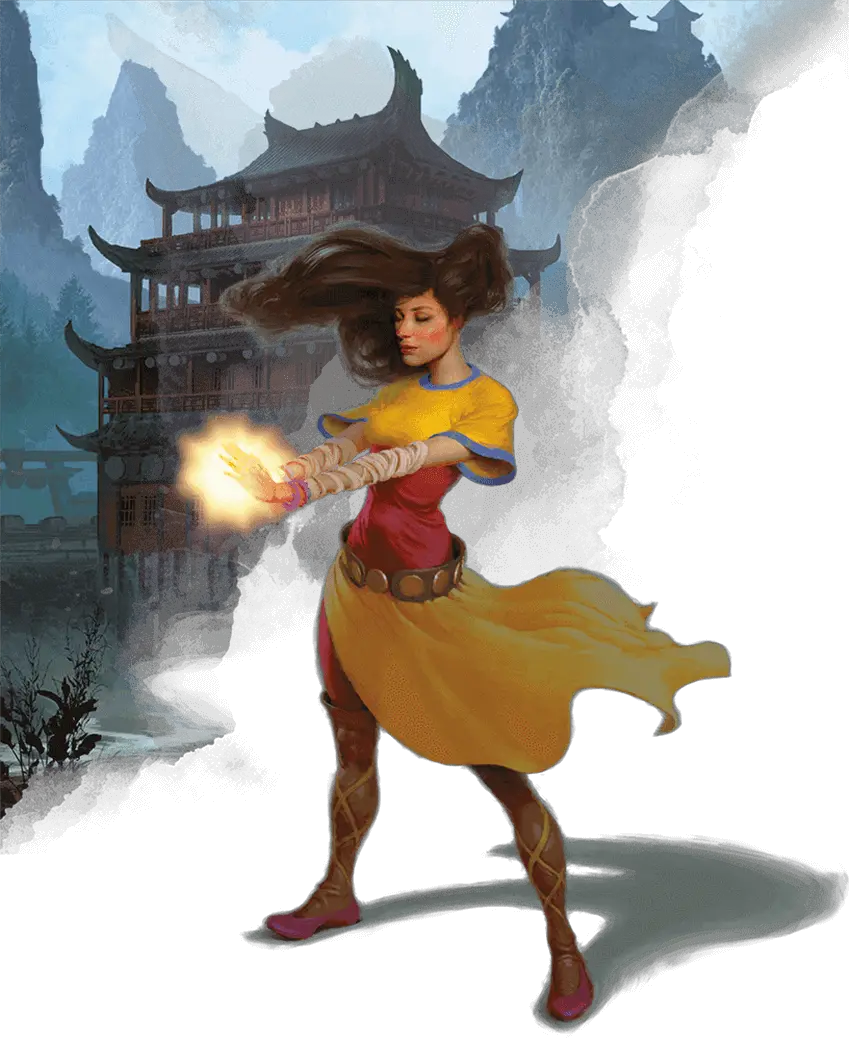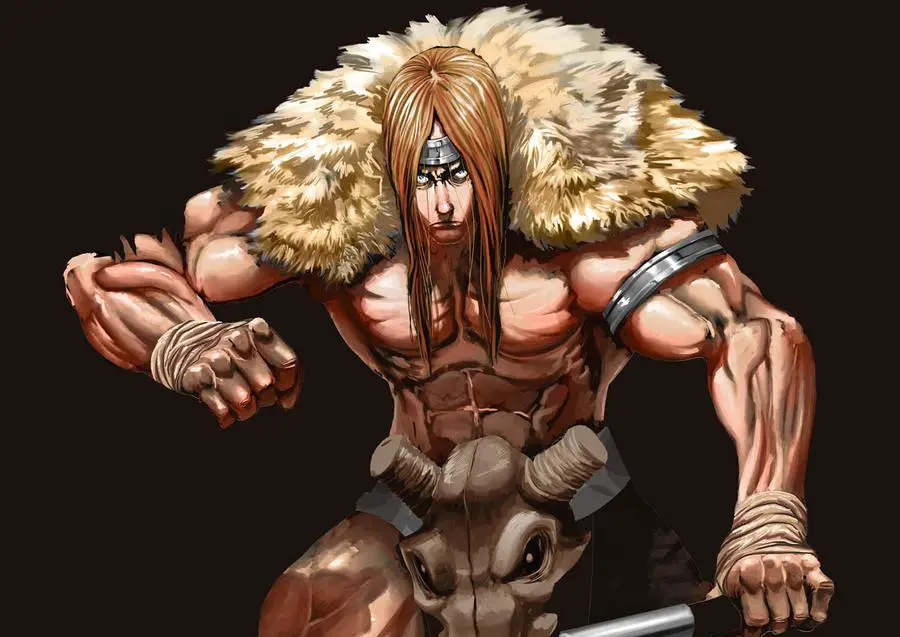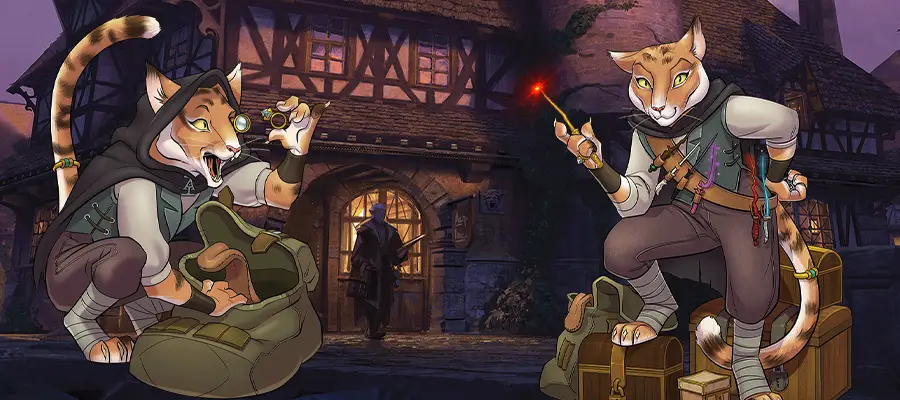Featured Way of the Open Hand Monk image credit to Wizards of the Coast’s D&D 5e Player’s Handbook.
Disclaimer: This article contains affiliate links that add gold to our coffers.
The Way of the Open Hand Monk was introduced in the Player’s Handbook. It’s the ‘classic’ Monk with an amazing capstone ability at level seventeen, although campaigns often don’t reach that level. Not everyone thinks it’s amazing, but I think it’s an exciting Monk feature to look forward to with anticipation.
This review will look at the Open Hand Monk features and how these work with the core Monk class features. Then it’ll review feats, races, multiclass options and finally combine them into several build concepts.
As always, these are just my thoughts. If you have any other ideas about the Open Hand Monk, I’d love to hear about them in the comments below!
3rd Level – Open Hand Technique
When you take The Way of the Open Hand at level 3, you gain an upgrade to your Flurry of Blows ability. If you hit a creature with a Flurry of Blows attack, you can impose one of three effects:
- Force a Dex save or knock a target prone.
- Force a Str save or push a target up to 15ft away.
- Stop a target taking reactions until the end of your next turn (no save).
All three can be applied to two targets, and all three give you an alternative to the Step of the Wind disengage option, allowing you to keep attacking while doing so. The no-save cancellation of all reactions is the most reliable. It’s a shame that the prone effect happens so late in your turn (Flurry of Blows is taken after your main attack action), it won’t benefit you that much, but it might help your allies. The push effect can be fun near cliff edges or if a party member has a nasty area of effect spell going on.
Using Flurry of Blows costs one ki point each time, so if you run out of ki, you also deplete your 3rd-level subclass feature.
6th Level – Wholeness of Body
Once per long rest, you regain 3x your Monk level hit points as an action. Simple and effective and should be preferred to Quickened Healing which costs ki. It’s a shame you can’t heal anyone else with this.
11th Level – Tranquility
This is a unique ability among Monks. After your long rest, you gain the effect of the sanctuary spell until the start of your next long rest.
Sanctuary usually only lasts one minute. You will lose the sanctuary if you make an attack, cast a spell that affects an enemy, or deal damage to another creature. Any creature who attacks you must first make a Wisdom save; if they fail, they either have to target someone else or lose their attack or spell.
You could conceivably become a pacifist and not attack anyone all day.
You can cast spells that help your party (taking a level of Cleric for Bless and Healing Word, for example) without breaking Sanctuary’s protection. Tranquility allows you to exclusively Dodge as your main action and become the party tank. Sanctuary doesn’t stop you from using the Help action to grant advantage to your allies’ next attack roll and then bonus action to Dodge. You can Use an Object or Activate an Item, too.
Some racial features work under Sanctuary without ending it. I’m particularly partial to “Grovel, Cower and Beg” from the Kobold (found in Volo’s Guide to Monsters). The Leonin Mighty Roar is another option (from Mythic Odysseys of Theros). If your DM lets you play a Grung, you can walk around touching enemies and inflicting the poisoned condition.
Or you could ignore the feature and carry on as normal. I think it opens up some interesting possibilities for an alternative playstyle for a Monk. I appreciate abilities that open up new playstyles, even if they’re not a power gamer’s dream.
17th Level – Quivering Palm
We’ve had to wait a long time for it, but here it is! Quivering Palm is the single most devastating ability of any Monk subclass.
When you have hit a creature with an unarmed strike, you can spend three ki to initiate imperceptible lethal vibrations that will last for days (equal to your Monk level).
You can end those vibrations as an action, and as long as the creature is on the same plane of existence, it must make a Con save. On a failure, it dies; on a success, it takes 10d10 necrotic damage. Only one creature can be under the effect of this feature at a time.
Note that this doesn’t work with Monk weapons; it has to be an unarmed strike. The new Focused Aim feature can help if you’re just short of landing that key attack roll.
It does look like you can apply multiple times to a single creature, and given that you attack up to four times, you could apply it to one creature four times in a single round. You can review rules for overlapping the same effects on a creature to brush up on how this resolves.
The only way to avoid this after it’s applied is to retreat to another plane of existence and hope the vengeful Monk doesn’t follow you.
You need to be picky about when you use Quivering Palm. Many powerful creatures have very high Con saves. It’s possible to use up a legendary resistance to avoid the instakill effect. It may be useful for you to attempt Stunning Strikes during the setup round for Quivering Palm to help burn through any legendary resistances first.
The obvious use for this is in combat, but it could be used as an interrogation and/or obedience enforcement technique. It can be applied to an unreliable NPC to make sure they will do what you’ve asked.
Open Hand Monk Subclass Summary
The Open Hand features are useful but not massively impactful until you reach level seventeen. If your campaign is unlikely to go that far, then this Monk is solid but unexceptional.
Open Hand Monk Feat Options
A feat that is not normally associated with Monks is Polearm Master, assuming you go with a quarterstaff. You probably won’t use the bonus action attack from this. The main benefit of Polearm Master is the opportunity attack you get when an enemy enters your reach. This can be a nice addition for a Monk who is manipulating enemies on the battlefield. You can cancel their reaction with your Open Hand Technique, fall back a bit, and hit them again when they approach you, potentially stunning them.
A good feat for all Monks is Crusher, but an Open Hand Monk synergizes with its battlefield control options. It works both with your unarmed strikes and any Monk weapons you have that deal bludgeoning damage. The extra 5ft knockback once per turn is useful by itself and synergizes quite nicely with the prone effect of the Open Hand Technique. The advantage gained from a critical hit helps you and the whole party until the start of your next turn.
These two feats synergize well with each other. Crusher is usable once per turn, including on an enemy’s turn, so it will work with the Polearm Master reaction to knock an enemy 5ft back again, potentially avoiding their attacks altogether.
My favorite feat for Monks is usually Mobile to avoid opportunity attacks from a single enemy I’ve attacked; however, the disengage options available to the Open Hand Technique make Mobile less useful. If you go for reach with a Bugbear as your race choice, you probably don’t need it at all.
Race Options
Variant Human and Custom Lineage give you that free feat, and given how feat-starved Monks can be, this can also be a great way to get started as a Monk.
If you’re planning to go with both Crusher and Polearm Master, you should either go for the free feat (so Variant Human or Custom Lineage) or the extra 5ft reach you can get on your own turn with a Bugbear.
Shifters are interesting options for Monks as well. While shifted, the Swiftstride Shifter gets a special reaction that allows you to move up to 10ft if an enemy ends its turn within 5ft of you. This can work well with some of the other Open Hand features.
A useful option for any Monk since Tasha’s is picking up any martial weapons proficiency. These can be swapped out for one or more weapons of choice to fire the new Dedicated Weapon feature (and give you a 1d10 versatile weapon attack die for your main attack) and/or converted into tools proficiencies. So Dwarves, Elves, Githyanki, Hobgoblins all make good race choices. However, if you’re planning to go with a quarterstaff, you won’t need this.
Multiclassing
I like dipping a level of Cleric for my Monk. Most Monks don’t have anything to do with their concentration, and a level of Cleric allows you to be a bit more versatile. You can concentrate on simple, effective spells like Bless to help your party while your spellcasters focus on other spells.
One level of Rogue is a nice option with extra proficiencies, expertise, and a little bit of Sneak Attack. This can allow your Monk to act as the party Rogue if needed.
If you wanted to go for the ultimate melee battlefield manipulator, you could add three levels of Fighter and choose Battlemaster. Your many attacks will allow you to nova and deplete your Superiority Dice quickly to knock out a formidable foe.
Ultimately, you want to reach level seventeen if you can, and sticking to Monk is the fastest way to get there. Multiclass with caution since Quivering Palm is so cool.
Build Ideas
My favorite build for an Open Hand Monk is a Bugbear with Polearm Master and Crusher, wielding a quarterstaff.
Two feats is a bit of a reach 😉 so I recommend taking Polearm Master early, maxing Dex, and then add Crusher later. You can use your reach to make hit-and-run attacks. Anything that moves close can be hit with an opportunity attack and (from level 5) stunned.
With both feats active on your own turn, you can knock an enemy within 5ft further away with Crusher but still be able to attack them with your longer reach (one of the downsides of Crusher is potentially moving an enemy out of your own reach). Then move 25ft backward. They will spend their 30ft movement getting to you, and you can use the Polearm Master reaction and Crusher knockback to knock them 5ft back. At that point, they run out of movement, can’t reach you, and forfeit their attacks. You can combine this approach in many ways with the Open Hand Technique. It’s a really flexible and fun build.
Summary
The Open Hand is average until level 17, at which point it becomes powerful. Some of its control options synergize well with some feats. It’s a solid subclass at low levels if you want to knock monsters around. This feels like the classic Monk archetype from past editions, to me.
This wraps up my review of the Way of the Open Hand! Cast Message in the comments section below to share your experiences with the subclass. You can read more articles by me, Shard, published with Flutes Loot: Shard’s articles. All Flutes Loot Monk articles can be found here. Happy adventuring to you this weekend!




